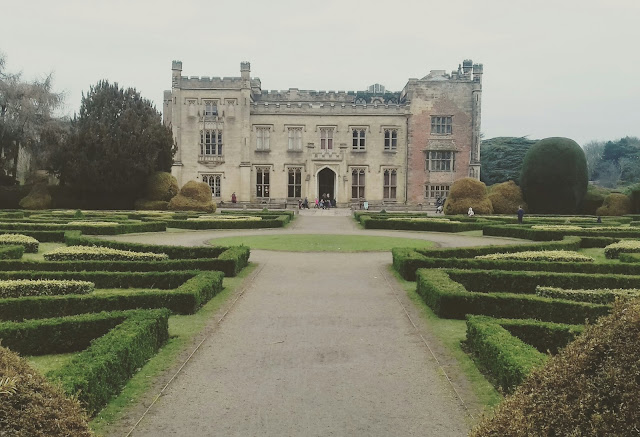Barrons Splendid Topiary
 |
| Elvaston Castle, Barron's Parterre garden |
Last Friday, I needed to go to Nottingham to collect a round
glass window, as you do (£19.95 – eBay bargain!). The journey took me along the
A50 from Stoke-on-Trent past Derby. It was far too good an opportunity passing
so close to Borrowash not to call in at Elvaston Castle for a bit of research.
One of the ‘Dead Gardeners’ associated with Betley Court is Scottish landscaper
William Barron. Barron was an inspirational gardener, skilled at grand horticultural
schemes and hard-landscaping, but also a knowledgeable nurseryman. Of course, he is
best known as the Tree Mover, and a leading light on the craft of topiary, both
exemplified to the highest level at Elvaston Castle gardens. I am always
surprised he is not better known or feted today.
Elvaston Castle was once the grand home of the forth Earl of
Harrington, and he employed Barron to redesign the garden as a loving tribute
to the earl’s wife, the actress Maria Foote. I don’t know if her profession inspired the
Earl or Barron, but Barron has used every design trick in the gardener’s repertoire
to create drama, mystery and theatrical experiences.
When I think of Derbyshire, the landscape in my mind is the
rugged rocky outcrops of the Peak District. The south of the county though, is
flat and undramatic pasture. This is the uninspiring landscape Barron was
confronted with when he started work. In fact, the Earl’s father had tried to
engage ‘Capability’ Brown to landscape the ground – Brown refused due to its
flatness!
 |
| Rock feature, framing the view |
Undaunted, Barron devised a way of draining the land,
creating a picturesque lake near the house. He then used earthworks, rock
features and evergreen planting to create an intriguing walk around the lake’s
banks. Cleverly, Barron used rocks to build follies that guide the eye across
the landscape and hold the viewers interest.
 |
Folly ruin
|
The Earl was an impatient patron, and wanted his garden
created quickly. Barron rose to the challenge, utilising evergreen trees to
make grand sweeping avenues and vistas, and perfecting his tree moving techniques. In an era of instant gratification,
when a monkey puzzle tree can be purchased 24/7 online, it is quite boggling to
see the range of expensive and difficult to acquire specimen trees Barron
planted during this transformation of the part of the Derbyshire lowlands. By
1850, he had planted every known species of European conifer in the grounds.
 |
| Church Avenue |
Yews were a passion with Barron, and the gardens at Elvaston
boast many varieties with different coloured leaves, incorporated into the
designs (including Cephalotaxus harringtonii – named in honour of the Forth
Earl). The designs are so playful. Giant yew peacocks guard the front of the Castle.
In the Italianate Garden coiffured topiary takes on the appearance of huge
chess pieces. To the west of the Castle, clipped symmetrical maze-like scrolls
dominate, the best view for visitors being from the top of a short flight of
steps (although I would love to see the view from the Castle top rooms).
Elsewhere, avenues frame views, and tempt visitors further into the gardens,
often with a focal point in the distance. Barron employed choice specimen
trees, architectural ornaments and sculptural topiary extravaganzas to draw
visitors on. And as buildings and
features within the garden have been designed to be ornamental (a Moorish
temple, a boathouse, the Golden Gates), the whole garden takes on the feel of a
series of theatrical stage sets. I like to think of the Countess Maria being cajoled
into performing monologues from her favourite plays to her adoring husband,
with Barron’s verdant planting as the scenery.
Today, anyone can visit Elvaston Castle gardens and view what
remains Barron’s fine work just for the cost of car parking. Given the grounds
were once maintained by an army of 80 gardeners, the current owners, Derbyshire
County Council do a great job with comparatively tiny budgets and limited
labour. I do hope you’ll take the time to visit one day. In the meantime, I’ll
leave you with links to websites that will tell you a little more. We’ve tentatively
talked about the possibility of a Barron’s
Trail, linking remaining examples of his garden designs with another garden
‘friends’ society, so who knows what the future will bring?
Best wishes
Ladybird Su









Comments
Post a Comment